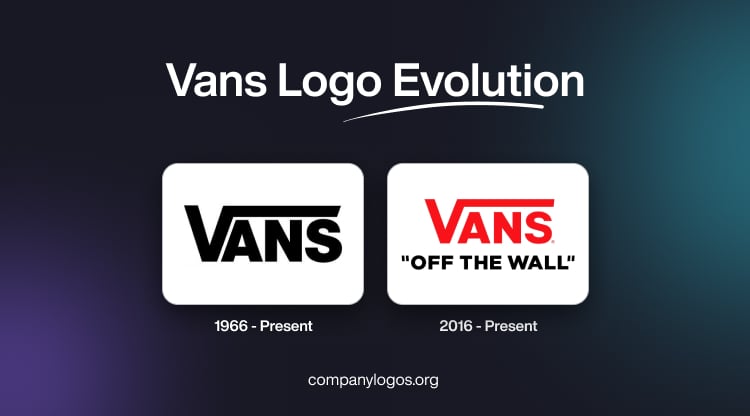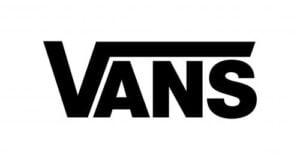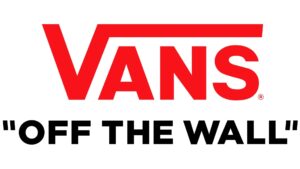
Vans is a California-based company that manufactures sports shoes, fashion accessories, and clothing. Established on March 16, 1966, by brothers Paul and Jim Van Doren as well as Gordo Lee and Serge Delia, the company was called The Van Doren Rubber Company initially. The logo of the company has changed just once after its design, which this article talks about, in addition to exploring other details about the company.
The Genesis of the Vans Logo (1966 – Present)
The first-ever Vans logo was conceived by Marc Van Doren, a 13-year-old and the offspring of one of the founders of the company. He devised a stencil intended for painting skateboards. James Van Doren promptly took notice of this graphical element and affixed it to the heel of Style 95 sneakers. Subsequently, the company owner made the strategic decision to mass-produce skateboard shoes.
This logo features the wordmark “Vans” in a black, bold, and thick uppercase sans-serif typeface and is known for an unconventional touch. For instance, it has a long horizontal line above the letters “A”, “N”, and “S”. Originating from the apex of the “V”, this line bears a visual resemblance to a mathematical root sign. This distinctive design evolved into a hallmark of the brand’s visual identity.

(2016 – Present)
In 2016, Vans introduced an updated version of its logo. It featured the “Off the Wall” slogan in black uppercase and within quotes, which the company embraced in 1976. The term “Off the wall” was a common slang phrase among skateboarders at the time. This refined image maintains a lot of the original aspects of the first Vans logo. The V still has an elongated arm stretching over the top of the other letters in the company’s name.
However, the letters in a sans-serif typeface have been straightened and sharpened to give the image a more sophisticated look. The colour palette is also updated, with the “Vans” wordmark appearing in a bright red shade on a white background. Underneath the main logotype, we see the company’s slogan, which features in many of the brand’s advertising campaigns.

The Elements of the Vans Logo
Symbol
The current Vans logo features the brand’s name in bold letters within a red rectangle. It shows the iconic “Off the Wall” slogan placed underneath in black.
Font
The typeface used in designing the Vans logo is strong, geometric, all-caps sans-serif, which is closely related to Helvetica but customised for the brand.
Colour
Since its inception, Vans has used different colour schemes. In the 1960s, the logo appeared as a blue wordmark on a white tag. Later, the introduction of the van-shaped logo brought in vibrant red hues. After a period of using a black-and-white palette, Vans adopted the now-familiar red-and-white combination, with black added for the slogan in the current version.
The History of Vans
Vans was founded as the Van Doren Rubber Company by brothers Paul and James Van Doren, along with partners Gordon Lee and Serge Delia, on March 16, 1966, in Anaheim, California. Their innovative business model was to manufacture shoes and sell them directly to the public, bypassing traditional retailers. On its opening day, the company sold 12 pairs of its first model, the #44 Deck Shoes—now known as the Vans Authentic. Interestingly, although there was no inventory ready, customers picked up their shoes the next day after they were made to order.
The brand quickly gained popularity, especially among skateboarders. This was due to its rugged construction and signature vulcanised waffle sole, which provided superior grip. This connection to skate culture was further cemented in the 1970s, when Mark Van Doren, who was the son of co-owner James Van Doren, designed the original Vans skateboard logo. He helped introduce styles like the Old Skool (with the iconic side stripe) and the Sk8-Hi.
By the late 1970s, Vans had introduced several now-classic models, which included the Old Skool, Slip-On, and Sk8-Hi. The Slip-On, in particular, became a cultural icon after being featured in the 1982 film Fast Times at Ridgemont High. During this period, Vans shoes became synonymous with California youth culture, skateboarding, BMX, and later, snowboarding.
Despite its popularity, Vans faced significant challenges in the 1980s. The company struggled with competition and counterfeiting, which led to financial difficulties and a bankruptcy filing in 1984. In 1988, Paul Van Doren sold the company to McCown De Leeuw & Co. in a leveraged buyout.
Vans made a comeback in the 1990s by embracing its roots in action sports and youth culture. The company expanded internationally, released new models, and became a public company in 1991. Vans also began sponsoring major events, most notably the Warped Tour music festival, which it supported from 1996 to 2019 and again in 2025. This association with music, skateboarding, and street culture established Vans as a symbol of American counterculture and creative expression.
In 2004, Vans was acquired by VF Corporation for around $400 million, thereby providing the resources for further global expansion. The brand also launched the Vans Customs platform, which allowed customers to design their own shoes online.
Today, Vans is a leading global brand in footwear, apparel, and accessories, particularly within skate, surf, and youth lifestyle markets. The company continues to innovate with new designs as well as maintain its classic styles. The influence of Vans extends beyond footwear, especially into shaping music, art, and street culture worldwide. Its commitment to authenticity and community remains central to its identity, which has made it a lasting icon in both fashion and sports.
Interesting Facts About Vans
- Vans was originally called the Van Doren Rubber Company and was founded on March 16, 1966, in Anaheim, California.
- The first day sales of the company were just 12 pairs of shoes, which customers had to pick up later that day because the shoes were made to order. Furthermore, the Van Doren brothers didn’t have change, so the customers returned the next day to pay, and all did.
- The first Vans shoe was the #44 deck shoe, which is now known as the Vans Authentic. It was a canvas deck shoe with a thick rubber sole designed for durability and grip.
- Vans shoes were originally numbered and not named. For example, the #95 is now known as the Vans Era, and the #36 is the Slip-On.
- The iconic Vans “jazz stripe” (now called the Sidestripe) was a random doodle by co-founder Paul Van Doren and debuted on the Old Skool shoe in 1977. It has become the unmistakable hallmark of the brand.
- Vans embraced skateboarding culture early on, with skateboarders adopting Vans for their rugged construction and sticky waffle soles by the early 1970s.
- The Vans Era model was designed by skateboarders Tony Alva and Stacy Peralta in 1976. It featured a padded collar for extra comfort and became a favourite among skaters.
- The Sk8-Hi, introduced in 1978, was the first Vans shoe to protect the ankle. It was designed to guard the ankles of skateboarders from injury while providing a distinctive style.
- The checkerboard pattern became an overnight icon after being featured in the 1982 film Fast Times at Ridgemont High.
- Vans filed for bankruptcy protection in 1984 due to overexpansion and financial struggles. However, it made a turnaround under the leadership of Paul Van Doren, who insisted on maintaining shoe quality despite budget cuts.
- The first signature skate shoe, the Steve Caballero “Half Cab”, was introduced in 1988. It became one of the most iconic skate shoes in history.
- Vans was a pioneer in customisation, for it allowed customers to bring their own fabrics and design unique shoes. The shows were made overnight due to their integrated manufacturing and retail model.
- The Vans waffle sole was a major innovation, created by heating and moulding rubber to produce a durable, flexible outsole that provided superior grip for skateboarders.
- The brand name “Vans” came from customers shortening “Van Doren” when referring to the shoes, which the company then adopted officially.
- Vans has maintained a strong connection to youth culture, music, and action sports. It sponsored events like the Warped Tour and collaborated with artists and designers worldwide.
Finally
The Vans logo demonstrates the brand’s capacity to appeal to and fit in with various demographics. Vans has upheld its dedication to individuality and self-expression throughout its history. The logo reflects the brand’s journey and captures the spirit of defiance, originality, and inventiveness that have defined Vans throughout the brand’s existence in the rapidly evolving fashion and young culture scenes.